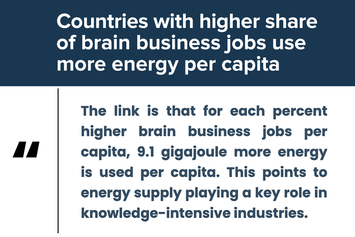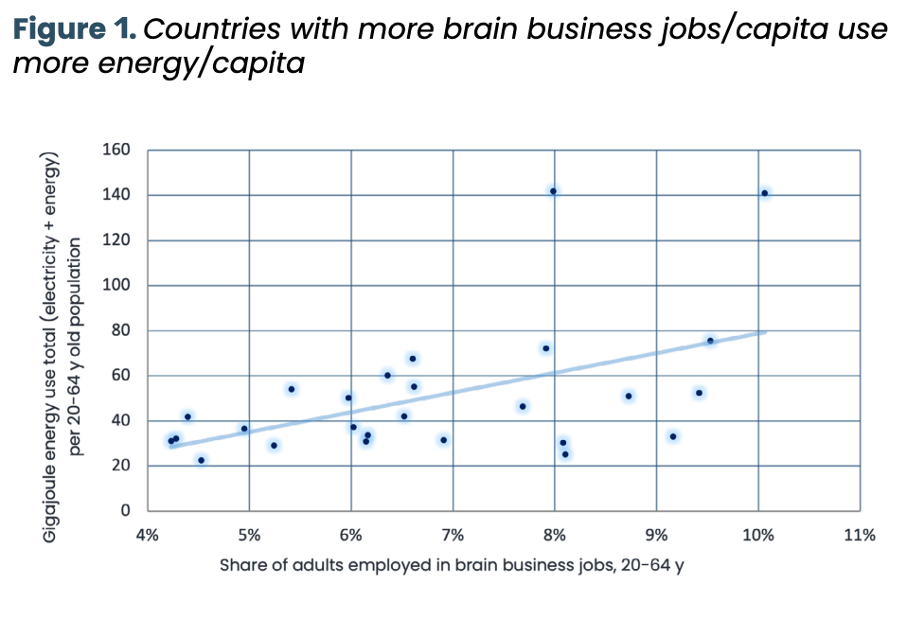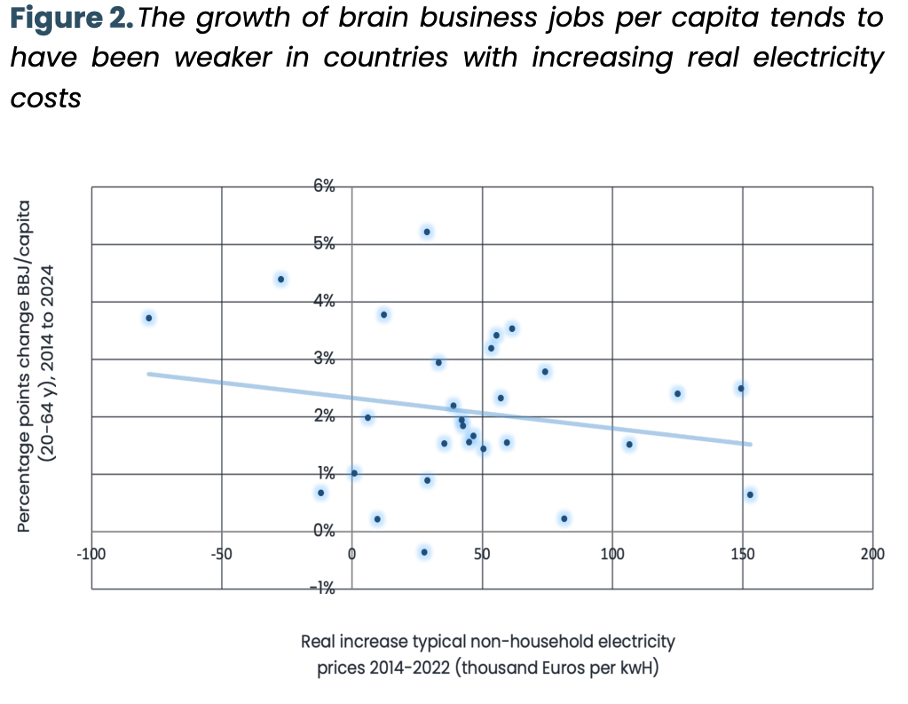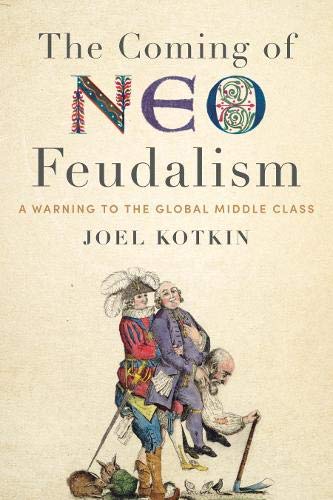
Energy is vitally important for economic growth, particularly those forms of energy that can be used for planned power delivery. It is evident for example that Germany is currently suffering from the past decisions to shut down rather than upgrade nuclear energy.
To better understand the trans-Atlantic patterns, it is possible to look at how many megajoules of energy that are used to create the equivalent of one $ of economic value, in different economies. At top we find Ireland, Malta and Switzerland, where less than 2 megajoules are used to create on average each dollar of economic value. All three are low tax and free market economies, attracting investments, finance companies, and knowledge intensive jobs.
Switzerland has the highest share of adults employed in so-called brain business jobs in Europe, a metric of knowledge intensive jobs in technology, advanced services, IT and creative professions. Ireland ranks second while Malta has climbed fast up to fourth rank. The Netherlands is the third most knowledge intensive economy in Europe, and has somewhat higher energy usage per produced value– which makes sense since there is more manufacturing and transport trade reliance in the Netherlands.
Denmark is flourishing thanks to pharmaceutical exports, which does require some energy per employee, but create such high value creation per employee that also the energy input is low. The UK has a strong finance sector reliance, again where high values are created for limited energy input.
Germany and Spain have a bit higher energy output per produced value, France even more. Sweden and Belgium with export-oriented manufacturing sectors have higher than that. The USA has a higher energy input than most of Europe, except Finland – and by wide margin Iceland. More energy is needed in Nordic countries, due to the cold weather. Nordic countries such as Sweden and Finland have water power supply, and are currently focused on expanding nuclear power to get more energy supply and less fluctuation in prices.
| Europe. USA & Canada: Energy usage per economic output Energy intensity level of primary energy Megajoules (mJ) per 2024 $ |
|||
| Ireland | 1.2 | France | 3.6 |
| Malta | 1.5 | Latvia | 3.7 |
| Switzerland | 1.9 | Hungary | 4.0 |
| Denmark | 2.3 | Poland | 4.0 |
| United Kingdom | 2.6 | Slovenia | 4.0 |
| Romania | 2.7 | Norway | 4.1 |
| Italy | 2.9 | Sweden | 4.2 |
| Portugal | 3.0 | Belgium | 4.4 |
| Cyprus | 3.0 | Slovak Republic | 4.9 |
| Germany | 3.2 | Czechia | 5.1 |
| Netherlands | 3.2 | Estonia | 5.3 |
| Spain | 3.2 | United States | 5.3 |
| Greece | 3.3 | Finland | 6.2 |
| Lithuania | 3.3 | Canada | 8.3 |
| Croatia | 3.5 | Iceland | 15.3 |
| Sources: World Bank. Bureau of Labor Statistics CPI Inflation Calculator and own calculations. Energy intensity level of primary energy is the ratio between energy supply and gross domestic product measured at purchasing power parity. Energy intensity is an indication of how much energy is used to produce one unit of economic output. Lower ratio indicates that less energy is used to produce one unit of output. | |||
Looking at the rate of change, it is the top-performing countries Ireland and Malta, alongside Lithuania and Romania, which have reduced energy usage for economic output by more than half between 2004 and 2022. Sweden, the Netherland and Estonia are amongst those to reduce by 40 percent the energy needed in economic production.
Germany has essentially same level of change in energy usage for economic output as does France. This is relevant, for while Germany has shifted from nuclear power – with significant effects on economic progress – France has been more oriented towards retaining and expanding nuclear power. Energy efficiency in terms of output for growth has not been significantly better in Germany, despite the costly energy decisions.
The economy of the USA has become 33 percent more energy efficient between 2004 and 2002. This means that the same energy that produced before two dollars of real value, now produce three dollars of real value. This rate of change is slightly lower than 35 percent in France and 37 percent in Germany.
Some European countries, such as Spain, Italy and Greece have reduced energy output of production less than the USA. In Canada the level has decreased by 19 percent since, lower than all of Europe except Iceland where it has increased by more than a fifth. Iceland combines the need for heat with geothermal energy, which can explain its unique energy situation.
| Percentage change in energy usage per real economic output 2004-2022 |
|||
| Ireland | -64 | Latvia | -36 |
| Malta | -61 | France | -35 |
| Lithuania | -56 | Belgium | -34 |
| Romania | -55 | United States | -33 |
| Slovak Republic | -48 | Croatia | -33 |
| United Kingdom | -45 | Cyprus | -32 |
| Poland | -43 | Hungary | -32 |
| Estonia | -41 | Portugal | -31 |
| Netherlands | -41 | Spain | -30 |
| Sweden | -41 | Finland | -29 |
| Switzerland | -39 | Norway | -26 |
| Czechia | -39 | Italy | -23 |
| Denmark | -39 | Greece | -22 |
| Slovenia | -38 | Canada | -19 |
| Germany | -37 | Iceland | +21 |
| Sources: World Bank. Bureau of Labor Statistics CPI Inflation Calculator and own calculations. Energy intensity level of primary energy is the ratio between energy supply and gross domestic product measured at purchasing power parity. Energy intensity is an indication of how much energy is used to produce one unit of economic output. Lower ratio indicates that less energy is used to produce one unit of output. | |||
Knowledge-intensive jobs tend to rely on energy. Therefore, investing in the infrastructure of energy production and delivery, is relevant for growth of brain business jobs. Indeed, a comparison shows that those countries which have a higher share of adults employed in brain business jobs, also tend to use more total energy per adult. For each percent higher share of adults in these knowledge-intensive job, 9.1 gigajoule more energy is used per capita.

Energy supply is needed to thrive economically, to grow with knowledge intensive jobs. Yet the most knowledge intensive economies of Europe have progressed to higher energy efficiency. So, while energy is crucial for growth, the efficiency of converting energy to economic value is highest in growing and business friendly economies.
Market driven growth of in particular knowledge intensive jobs is closely related to energy supply, as the same time that the best performing knowledge intensive economies are best at creating value for a lower level of energy usage.
Nima Sanandaji, Director, European Centre for Entrepreneurship and Policy Reform (ECEPR)













